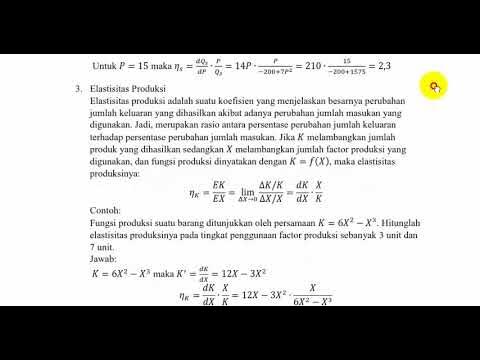Price Elasticity of Supply (PES) | Elasticity | IB Microeconomics
Summary
TLDRThis video explores the concept of price elasticity of supply (PES), which measures how the supply of a product changes in response to price changes. It explains the formula for PES and the different ranges: elastic (greater than 1), inelastic (less than 1), unit elastic (equals 1), perfectly elastic (infinity), and perfectly inelastic (zero). Real-world examples, like Chile's copper production and international wheat trade, illustrate these concepts. The video also highlights the importance of PES for firms in maximizing profits and for governments when considering market interventions like taxes or price controls.
Takeaways
- 📈 Price elasticity of supply (PES) measures how much the supply of a product changes in response to a change in the product's price.
- 🔄 Suppliers adjust their supply based on price changes, but the speed and flexibility depend on the nature of the product.
- ⛏ Products like copper have lower elasticity because production is slower and more complex, while items like flip-flops have higher elasticity due to quicker production times.
- 🧮 The formula for PES is the percentage change in quantity supplied divided by the percentage change in price, with the outcome always being a positive number.
- 📊 If PES is greater than 1, supply is elastic; if it is less than 1, supply is inelastic. If PES equals 1, supply is unit elastic.
- 🚫 Perfectly inelastic supply (PES = 0) means a change in price has no effect on the quantity supplied, often seen in industries like mining where increasing production takes significant time.
- ∞ Perfectly elastic supply (PES = infinity) means even a slight price change results in no supply, as seen in some international trade markets where large amounts of a commodity like wheat are available.
- 🏭 Price elasticity is crucial for firms to adjust their production in response to future price changes, helping them maximize profits.
- 🌾 In agriculture, farmers cannot quickly switch crops in response to price changes, limiting their ability to optimize profits based on market conditions.
- 🏛 Governments use PES to make informed decisions about price controls, taxation, and subsidies, understanding how producers will react to changes in the market.
Q & A
What is price elasticity of supply?
-Price elasticity of supply is a measure of how much the supply of a product changes when there is a change in the price of that product. It examines the flexibility of suppliers in responding to price changes.
How does price elasticity of supply differ from price elasticity of demand?
-While price elasticity of demand focuses on how consumers react to price changes by altering the quantity demanded, price elasticity of supply looks at how suppliers adjust the quantity they produce or supply in response to price changes.
What is the formula for calculating price elasticity of supply (PES)?
-The formula for price elasticity of supply is: PES = percentage change in quantity supplied / percentage change in price.
What does it mean when the price elasticity of supply is greater than 1?
-When PES is greater than 1, supply is considered elastic. This means suppliers can respond quickly and significantly to price changes by adjusting the quantity supplied.
What does it mean if the price elasticity of supply is less than 1?
-If PES is less than 1, supply is inelastic, meaning that suppliers cannot adjust their supply as easily or quickly in response to price changes.
What are the two special cases of price elasticity of supply?
-The two special cases are perfectly elastic supply, where PES equals infinity, and perfectly inelastic supply, where PES equals zero.
What does perfectly elastic supply mean?
-Perfectly elastic supply means that even the slightest change in price will result in suppliers either providing no supply or an infinite amount of supply, depending on the price level. The supply curve in this case is horizontal.
What is perfectly inelastic supply?
-Perfectly inelastic supply occurs when changes in price have no effect on the quantity supplied. The supply curve is vertical, indicating that no matter how much the price changes, the quantity supplied remains constant.
Why is price elasticity of supply important to firms?
-Price elasticity of supply is important to firms because it helps them adjust their production levels based on expected price changes, allowing them to maximize profits by responding flexibly to market conditions.
Why is price elasticity of supply important to governments?
-Governments must consider price elasticity of supply when implementing policies like price floors, ceilings, or taxes, as it affects how producers will respond to these interventions and the overall impact on the market.
Outlines

Cette section est réservée aux utilisateurs payants. Améliorez votre compte pour accéder à cette section.
Améliorer maintenantMindmap

Cette section est réservée aux utilisateurs payants. Améliorez votre compte pour accéder à cette section.
Améliorer maintenantKeywords

Cette section est réservée aux utilisateurs payants. Améliorez votre compte pour accéder à cette section.
Améliorer maintenantHighlights

Cette section est réservée aux utilisateurs payants. Améliorez votre compte pour accéder à cette section.
Améliorer maintenantTranscripts

Cette section est réservée aux utilisateurs payants. Améliorez votre compte pour accéder à cette section.
Améliorer maintenantVoir Plus de Vidéos Connexes
5.0 / 5 (0 votes)






